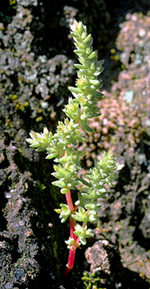 |
Most species of Crassulaceae occur in the deserts of South Africa and Central America. Only Crassula is native to Australia, mostly in the southern States in dry, open sites (although one species, C. helmsii, is an aquatic). Several other genera are garden escapes found in disturbed places around cities and along roadsides.
Characteristic features of the family Crassulaceae in Australia include: - herbs, small or robust, with more or less sessile, opposite or alternate, succulent leaves
- flowers with the corolla spreading or tubular, white, yellow, red or pink
- ovary comprising a whorl of 3-5 free carpels, each with several to many ovules, forming a cluster of follicles in fruit
Description
Annual or perennial terrestrial herbs, often succulent or semisucculent, or rarely aquatic herbs rooted in the substrate with their leaves emergent, rarely evergreen shrubs. Perennating by tubers, crowns or ?taproots. Vegetative reproduction absent or by stolons, bulbils or detached stem parts. Stem nodes rarely conspicuously swollen. Internal secretions not obvious. Plants glabrous or rarely with simple, non-glandular, unicellular hairs. Leaves alternate and spiral, or opposite, cauline if herbs, subsessile or sessile, or rarely petiolate. Stipules absent. Lamina simple, symmetric, pinnatifid, rarely pinnatisect; lamina/leaflets filiform, acicular, subulate, linear, lanceolate, ovate, elliptic, oblanceolate, ovate, oblong or orbicular; base cuneate, rarely rounded or cordate; margins entire, dentate, rarely serrate or sinuate, ±flat; one-veined, or the venation pinnate, or not obvious, with the midrib inconspicuous, and the tertiary venation not reticulate; surfaces rarely pellucid-punctate; succulent. All the flowers bisexual. Inflorescences terminal or axillary, consisting mostly of thyrses or dichasial cymes, or rarely of solitary flowers. Bracts present, rarely absent. Bracteoles present or absent. Flowers odourless; stalked. Floral disc present or absent; nectaries present on the disc or the carpels. Free hypanthium absent or rarely ±present. Perianth regular, of 2 dissimilar. Calyx segments free or fused, with 3–5 (–12) sepals or lobes, open in bud; calyx cup-shaped or bell-shaped, succulent. Corolla segments free or fused, with 3–5 (–12) petals or lobes, alternating with the sepals or calyx lobes, imbricate in bud; corolla wheel-shaped, cup-shaped, bell-shaped, urn-shaped or tubular, white, cream or yellow, rarely orange or red, without contrasting markings, or streaked, spotted, etc, membranous or succulent; claws absent; lobes ±entire. Fertile stamens 5, 8 or 10 (or 18–22), alternating with or both opposite to and alternating with the sepals or calyx lobes and then regularly alternating long and short, apparently free of or at least partly fused to the corolla, free of the ovary and style, distinct from each other. Anthers dorsifixed or basifixed, not versatile, opening sideways or rarely inwards by longitudinal slits; 2-celled. Ovary superior and sessile. Carpels 3–5, free. Style terminal, single and unbranched. Ovules 1–numerous per locule, stalked; placentation axile or marginal. Fruit a dry, dehiscent, apparently valvular capsule but truly follicular; the perianth on the maturing fruit dry and persistent, rarely growing larger. Disseminule micro-surface ±papillate, alveolate or rugose, brown; dull or rarely glossy. Seeds 1–numerous per fruit. Aril absent. Cotyledons 2. Embryo straight.
(Note: this description has been generated from the coded data compiled for the key. Any errors in the key data will be reflected in the descriptions.)
A treatment of the family Crassulaceae has not yet been published in the
Flora of Australia. It will appear in Volume 10.
Australian genera of Crassulaceae (as recognised for the Flora of Australia)
† = some species native, others introduced
* = all species introduced
*Aeonium
*Bryophyllum
*Cotyledon
†Crassula
*Kalanchoe
*Sedum

|
  |

Bryophyllum delagoense (flowers)
Photo: G.Leiper © G.Leiper

Bryophyllum pinnatum (flowers)
Photo: G.Leiper © G.Leiper

Crassula peduncularis (flowering plant)
Photo: K.Thiele © ABRS

Crassula sieberiana (flowering plant)
Photo: K.Thiele © ABRS
|
 |
|